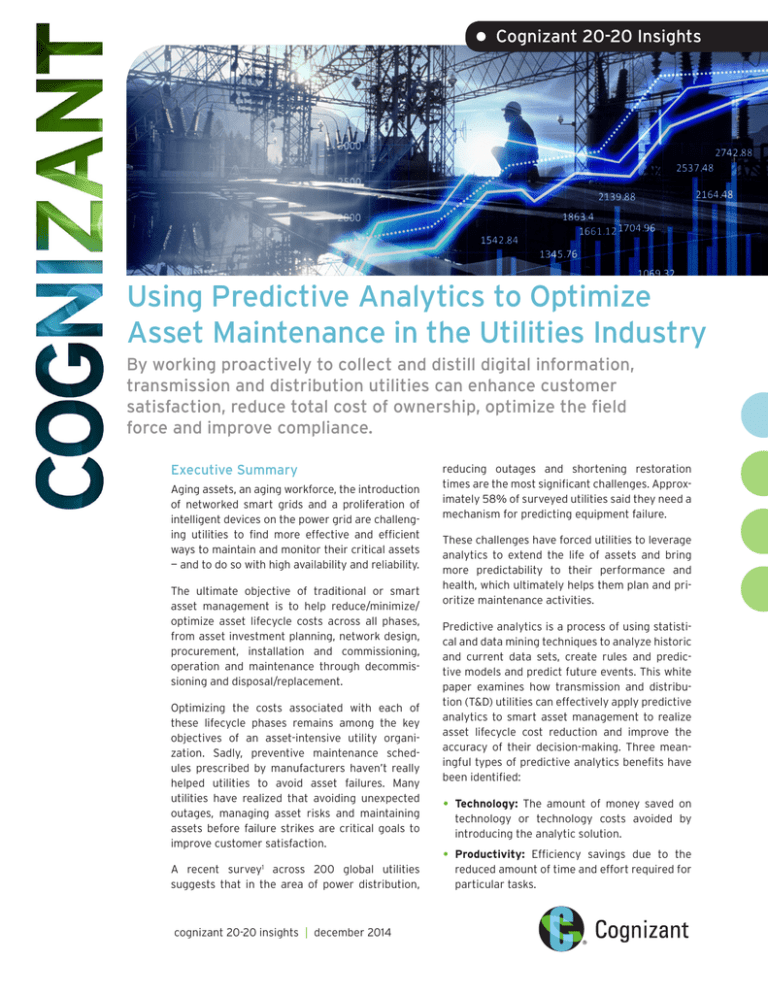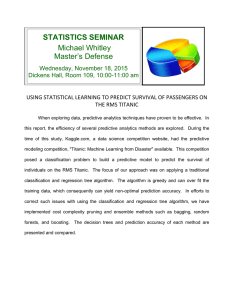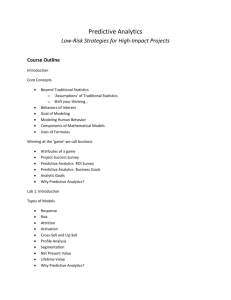
• Cognizant 20-20 Insights
Using Predictive Analytics to Optimize
Asset Maintenance in the Utilities Industry
By working proactively to collect and distill digital information,
transmission and distribution utilities can enhance customer
satisfaction, reduce total cost of ownership, optimize the field
force and improve compliance.
Executive Summary
Aging assets, an aging workforce, the introduction
of networked smart grids and a proliferation of
intelligent devices on the power grid are challenging utilities to find more effective and efficient
ways to maintain and monitor their critical assets
— and to do so with high availability and reliability.
The ultimate objective of traditional or smart
asset management is to help reduce/minimize/
optimize asset lifecycle costs across all phases,
from asset investment planning, network design,
procurement, installation and commissioning,
operation and maintenance through decommissioning and disposal/replacement.
Optimizing the costs associated with each of
these lifecycle phases remains among the key
objectives of an asset-intensive utility organization. Sadly, preventive maintenance schedules prescribed by manufacturers haven’t really
helped utilities to avoid asset failures. Many
utilities have realized that avoiding unexpected
outages, managing asset risks and maintaining
assets before failure strikes are critical goals to
improve customer satisfaction.
A recent survey1 across 200 global utilities
suggests that in the area of power distribution,
cognizant 20-20 insights | december 2014
reducing outages and shortening restoration
times are the most significant challenges. Approximately 58% of surveyed utilities said they need a
mechanism for predicting equipment failure.
These challenges have forced utilities to leverage
analytics to extend the life of assets and bring
more predictability to their performance and
health, which ultimately helps them plan and prioritize maintenance activities.
Predictive analytics is a process of using statistical and data mining techniques to analyze historic
and current data sets, create rules and predictive models and predict future events. This white
paper examines how transmission and distribution (T&D) utilities can effectively apply predictive
analytics to smart asset management to realize
asset lifecycle cost reduction and improve the
accuracy of their decision-making. Three meaningful types of predictive analytics benefits have
been identified:
• Technology: The amount of money saved on
technology or technology costs avoided by
introducing the analytic solution.
• Productivity:
Efficiency savings due to the
reduced amount of time and effort required for
particular tasks.
How Predictive Analytics Can Help T&D Utilities
Field Crew
Efficiency
■
■
Shift to predictive
maintenance
improves crew
utilization.
Work order process
synergies by EAM
integration.
Customer
Satisfaction
& Reliability
■
Avoid unexpected
outages.
■
Proactive outage
communication to
customer.
Safety and
Compliance
■
Proactively address
potential safety
risks and
compliance issues
by collating and
analyzing data from
multiple sources.
Reduce Total
Cost of
Ownership
■
Factor in actual
health of equipment
into maintenance
planning.
■
Avoid leading
cost component –
failure cost.
Figure 1
• Business process enhancement: All identifi-
to procurement, installation, operations and
maintenance, failure and decommissioning.
Unexpected failure cost is the leading expense
component of any asset. Failure cost includes
the expense of the asset in service, collateral
damage cost, regulatory penalty, disposal
of damaged asset, lost revenue, intangible
costs, etc. Thus, utilities can save a significant
amount of money by avoiding key equipment
failure. Predictive maintenance practices
utilize historical data from multiple sources
to build accurate, testable predictive models,
which allows us to generate predictions and
risk scores. Modeling techniques produce
interpretable information allowing personnel
to understand the implications of events,
enabling them to take action based on these
implications.
able annual savings that were realized due to
changes in business process supported by the
analytic application.
The Business Case for Predictive
Asset Analytics
As Figure 1 illustrates, predictive asset analytics
can be counted on to help T&D utilities achieve
the following objectives:
• Improved customer satisfaction and reliabil-
ity of power: Customer satisfaction and power
reliability are two important measures of a
utility’s performance. Unexpected equipment
failures impact both measures. Customers
expect planned outages to be communicated in
advance to plan their electricity consumption.
Utilities are also under pressure from strict
outage regulations to proactively maintain
their assets before failure to avoid penalties.
The reliability metrics that U.S. utilities must
report to regulatory authorities Include:
• Better
route planning and optimization of
field crews: A clear understanding of asset
health can help utilities in work planning,
prioritization and scheduling. Unexpected
equipment failure often requires reallocation
of crews from other work locations to restore
the outage, hiring of extra labor and contractors and, often, a complete rescheduling of
other planned maintenance activities. The
percentage of work from reactive activities, in
our view, can be effectively used for predictive
maintenance, thus improving crew response
time and utilization and reducing total maintenance duration and asset down time.
>> SAIDI:
The minutes of sustained outages
per customer per year.
>> SAIFI: The number of sustained outages per
customer per year.
>> MAIFI: The number of momentary outages
per customer per year.
• Reduced total cost of ownership by prioritiz-
ing maintenance activities: Each asset has
multiple associated costs — primarily related
cognizant 20-20 insights
2
• Improvement on overall safety and compli-
ance: Predictive asset analytics will proactively
address potential safety risks. By integrating
data from multiple sources — SCADA, EAM-GIS,
online monitoring systems, weather channels
along with nonoperational data (vendor
provided operational rules, equipment data
sheets, industry standards, etc.) — utilities can
quickly identify safety risks and take suitable
operation actions to mitigate them.
• Choosing the right technology platform: The
appropriate choice of platform typically depends on application scope, such as use cases
and response times, the volume and variety of
data, the existing systems environment and
extensibility to accommodate future needs.
The platform should be able to handle both
unstructured and structured data including
events, time series and metadata.
Advanced computing capabilities such as
in-memory processing and 3-D storage are also
required for providing services such as searchquery-aggregate on the go. For advanced
analytics, the platform should be capable of
integrating with third-party statistical and
modeling tools, such as R and SAS, as well
as real-time event processing to apply these
models and logic to identify root causes and
predict failures before they happen.
Predictive Asset Analytics
Implementation Challenges
As utilities embrace predictive analytics to
enhance asset management, they need to come
to grips with the following issues:
• Data
management: The shift to a predictive
analytics solution brings multiple challenges in
data management. These include:
>> Data quality: Predictive analytics solutions
• Uncertainty in implementation cost and ROI:
The ROI models for predictive asset solutions
are often complex and are not generic for all
assets. Predictive asset analytics is about maximizing asset utilization while minimizing unexpected failures, Cap-Ex and Op-Ex. However,
failure avoidance can lead to additional
maintenance work on the asset. Thus, any
reduction in failure cost will lead to increases
in maintenance costs. Predictive maintenance
also brings savings in work management by
diverting reactive maintenance workloads to
planned maintenance. By thus increasing the
efficiency of maintenance schedules, costs
and resources, it results in fewer outages and
higher customer satisfaction.
are intended to collect data across internal
systems such as EAM, SCADA, Historian
and online monitoring systems. The common issues seen include duplicate data, different time stamps in multiple systems for
the same data and conflicting information in
multiple systems. Poor data quality results in
bad analysis and recommendations.
>> Data
to look for: Subject matter experts
need to define input data requirements
for solutions. Identification of critical data
points and exclusion of less relevant data
items are essential before going ahead with
predictive analytics.
>> Integrated data collection: The existence of
multiple data silos is another problem. Utilities use multiple systems such as SCADA,
EAM, online monitoring, etc., which often do
not easily communicate with one another.
A predictive solution should be able to integrate legacy systems and new systems such
as GIS, weather and events systems to build
accurate, testable predictive models.
Predictive Asset Analytics:
One Solution
Once the utility has selected critical assets that
should be placed under predictive maintenance,
we suggest the following approach.
• Define
contributing parameters. A business
SME-guided approach is better than a purely
data-driven approach. The first step is to define
the input variables for analysis. Most of the
contributing parameters to asset failure are
known to the SME. Statistical analytics can add
value by improving rules, as well as identifying
and bringing more variables under monitoring
and analysis.
>> Dealing
with large data sizes: Traditional
legacy systems are not designed for handling today’s volume of data needed for
predictive analysis (e.g., terabytes of data).
Depending on the scope of the solution, a
utility should create an approach for managing data or adopt a big data platform for
managing the data.
cognizant 20-20 insights
• Create
known domain rules. Condition
monitoring rules are based on known relation-
3
ships between the contributing variables and
the failure event. In addition to known rules,
custom action rules can be configured to
trigger automatic work orders.
mation from multiple systems and configure
known alerts and actions rules for meaningful
asset management. The same functionality can
be used to configure alerts and actions rules
based on statistical analysis, taken from the
asset model.
• Create
unknown rules based on analytics.
Analyze holistic historical asset failure information from SCADA/Historian, EAM systems,
weather feeds and online monitoring systems
to gain insights into failures. Given the
multitude of statistical analysis methods
available, the utility must carefully evaluate the
solution objectives and data elements to make
an informed choice. After analysis, create new
prediction rules based on insights, assign risk
levels and automate work order actions.
• Prediction
notification: A summary view of
recent notifications in the main screen can
easily attract the utility operator’s attention,
thus enabling him to act quickly to avoid
failures. A detailed view of predictive alerts will
help the utility operator to explore the nature
of alerts in detail and make informed decisions.
The EAM system should be integrated with a
predictive system; this enables the user to view
asset-specific work-order status and trigger
new work orders directly from the predictive
solution, based on predictive alerts.
Key solution components include:
• An operations dashboard: Business users will
appreciate a GIS-enabled, intuitive summary
dashboard with quick summary of alerts and
work orders.
A conceptual solution architecture is illustrated
in Figure 2. The contributing parameter data
(real-time and history) is collated from multiple
systems and managed by a big data server, which
has high availability and fault tolerance capabilities and is equipped to handle a large volume and
variety of data. External systems such as EAM and
GIS are integrated with the applications server.
The core part of this environment is the analytics
engine, which can either be part of the platform
• An asset model: A statistical module is required
to analyze the historic event information and
to create an asset model. Real-time information will be compared with the reference asset
model to predict the failure event.
• Rules
setup: Organizations must provide
an intuitive interface to help users pull infor-
Anatomy of a Predictive Analytics Asset Management Environment
Operations
Dashboard
Predictive
Notifications
Asset
Model
Predictive
Rules Setup
Functionalities
Interface
Interface
Application Server
GIS Service
Data Source
Security
Authorization
KPI
Scheduled Jobs
Enterprise
Asset
Management
Analytics Engine)
External
systems
Data
Server
Predictions/
Weather
Notifications
Data
Portal Data
Internal
systems
Rules Repository
Real-time/Historic Data
SCADA/
Historian
Weather
Service
Online Monitoring
Systems
Figure 2
cognizant 20-20 insights
4
Archive DB
or integrated via a third-party component. An
ideal solution should support desktop and mobile
interfaces, with solution components such as an
operations dashboard, predictive notifications,
asset models and predictive rules engine.
culture to reinforce its viability as many SMEs
retire or leave the workforce.
• Team
play is needed among players to
succeed in implementation. Implementation
quality is an important issue that prevents
utilities from achieving projected results from
predictive analytics programs. Very few solution
providers have an end-to-end capability to
implement predictive solutions. To mitigate the
implementation risk, utilities should involve
multiple providers and encourage “team play.”
This strategy will bring best-in-class in solution
components provided by various expert players
in data management, systems integration,
analytics engines and operational technology
integration.
Looking Forward
As organizations move forward on their predictive analytics journeys, we recommend the following:
• Tightly
define the business need, future
requirements and solution extensibility.
Utilities need to ensure that a predictive asset
analytics solution fits into their overall business
strategy and future business requirements.
We suggest utilities decide on three elements:
define the immediate objectives of the solution;
understand future business requirements;
and assess the extensibility requirements to
support additional applications. Once these
aspects are known, the analytics platform and
statistical method for the solution will more
easily follow.
• Have you calculated your returns correctly?
Calculating ROI for predictive analytics is
difficult. While many of the benefits, such
as better communication and improved
knowledge, are intangible, an effort should
be made to quantity the benefits of a better
operational decision. Due care must be given
and include scenario analysis; direct and
indirect impact on cost and revenue components; improved process benefits; and related
synergies derived from predictive asset
solutions.
• Improve process and upgrade IT infrastruc-
ture. Most utilities may not have the right
processes and data needed to support analytics
solutions. Therefore, it is imperative to improve
business processes and upgrade IT infrastructure to support any analytics solution before
it is deployed. A utility can choose to follow a
step-wise approach where it first implements
the analytics capability, addressing existing
process and infrastructure needs, and then
gradually rolls out advanced analytics functionalities to fit with ongoing process improvement and IT system upgrades.
Rather than implementing only ”must have’”
functionalities in the solution, utilities should
carry out cost-benefit analyses that include the
deployment of ”must haves,” ”should haves”
and “may haves,” and understand the complete
benefits before deciding on the scope of the
solution. Experience shows that the addition
of more functionality — thereby extending the
program scope — can significantly increase ROI
in the long term.
• Embrace
a data-driven culture. Presently,
most utilities follow a person-centric approach.
They completely rely on the experience of their
engineers. Given the industry’s aging work
force, the time has come to adopt a data-driven
Footnote
1
Ventyx Electric Utility Executive Insights Annual Survey Results, 2013.
cognizant 20-20 insights
5
About the Authors
Quang Nguyen is a Consulting Director within Cognizant Business Consulting’s Energy and Utilities
Practice. He has over 15 years of consulting experience, 10 of which were spent in manufacturing. Quang
has experience in smart grid initiatives, including EE/DR programs, assets management, security,
customer portals, SAP CRM, GIS, HAN, smart meter network operations, alerts and notifications,
OMS, data governance, customer/operations analytics and rate calculation engines. He holds a B.A. in
chemical engineering from Case Western Reserve University, an M.S. in applied math and statistics from
Rochester Institute of Technology and an M.B.A. from University of Rochester. He can be reached at
Quang.Nguyen2@cognizant.com.
Sachin Kumar is a Senior Manager of Consulting within Cognizant Business Consulting’s Energy and
Utilities Practice. He has 18-plus years of global energy and utilities experience in consulting and business
operations and has led consulting engagements with several large global energy utility companies.
Sachin is also responsible for developing Cognizant’s utilities industry solutions, with a focus on the
T&D segment. He is a certified energy manager and auditor and has a degree in electrical engineering
and a post-graduate certification in general management. He can be reached at Sachin-12.Kumar-12@
cognizant.com.
Girish K.G is a Senior Consultant within Cognizant Business Consulting’s Energy and Utilities Practice.
He has more than seven years of global energy and utilities experience in consulting as well as plant
operations and maintenance. Girish has been in client-facing lead roles in multiple consulting engagements, where he has offered counsel on process transformation and business requirements. He has
strong experience in asset management, work management, retail and C&I billing, complex pricing and
product management. Girish holds a post-graduate degree in management from Indian Institute of
Management. He can be reached at Girish.KG@cognizant.com.
Acknowledgment
The authors wish to thank Jessy Smith, a Senior Architect within Cognizant’s EMS Business Unit, for her
valuable inputs to this white paper on analytics platforms.
About Cognizant
Cognizant (NASDAQ: CTSH) is a leading provider of information technology, consulting, and business
process outsourcing services, dedicated to helping the world’s leading companies build stronger businesses. Headquartered in Teaneck, New Jersey (U.S.), Cognizant combines a passion for client satisfaction,
technology innovation, deep industry and business process expertise, and a global, collaborative workforce that embodies the future of work. With over 75 development and delivery centers worldwide and
approximately 199,700 employees as of September 30, 2014, Cognizant is a member of the NASDAQ-100,
the S&P 500, the Forbes Global 2000, and the Fortune 500 and is ranked among the top performing and
fastest growing companies in the world. Visit us online at www.cognizant.com or follow us on Twitter: Cognizant.
World Headquarters
European Headquarters
India Operations Headquarters
500 Frank W. Burr Blvd.
Teaneck, NJ 07666 USA
Phone: +1 201 801 0233
Fax: +1 201 801 0243
Toll Free: +1 888 937 3277
Email: inquiry@cognizant.com
1 Kingdom Street
Paddington Central
London W2 6BD
Phone: +44 (0) 20 7297 7600
Fax: +44 (0) 20 7121 0102
Email: infouk@cognizant.com
#5/535, Old Mahabalipuram Road
Okkiyam Pettai, Thoraipakkam
Chennai, 600 096 India
Phone: +91 (0) 44 4209 6000
Fax: +91 (0) 44 4209 6060
Email: inquiryindia@cognizant.com
­­© Copyright 2014, Cognizant. All rights reserved. No part of this document may be reproduced, stored in a retrieval system, transmitted in any form or by any
means, electronic, mechanical, photocopying, recording, or otherwise, without the express written permission from Cognizant. The information contained herein is
subject to change without notice. All other trademarks mentioned herein are the property of their respective owners.




